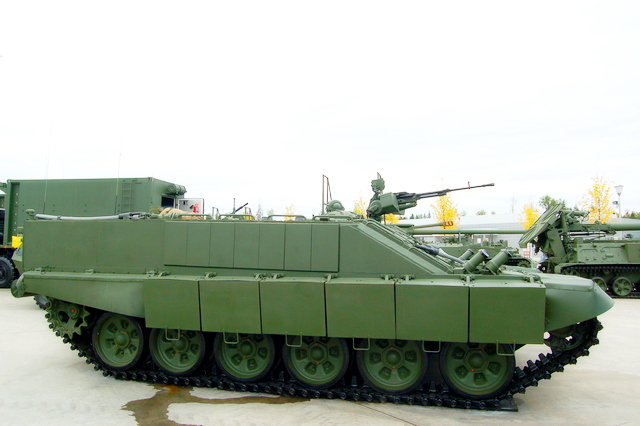
Image source: vestnik-rm.ru
Armored personnel carriers and infantry fighting vehicles on the chassis of tanks were created in various states. According to some reports, Russian military scientists began to think about well-armored means of delivering motorized infantry after analyzing the experience of the October 1973 war in the Middle East.Then the parties involved in the conflict suffered enormous losses in armored vehicles, including light ones.
However, the first domestic armored vehicle for transporting motorized infantry in the heavy weight category was demonstrated only in the 90s. Specialists and ordinary visitors saw the BTR-T at the II-th International Exhibition of Ground, Air Equipment and Weapons of the Ground Forces and conversion Products "VTTV-Omsk-97" held in Omsk.
According to " RG: Russian weapons ", the basis for it was the famous Soviet T-55. At the same time, it was stated that such an armored personnel carrier could be created on the chassis of any domestic tank.
Unlike the Israeli Achzarit, the designers did not carry out a radical redesign of the case, which significantly simplified, reduced the cost and accelerated production. The tower with the 100-mm rifled gun D-10T2S was removed, installing instead a single-seat combat module with a 30-mm rapid-firing gun 2A42, capable of fighting not only enemy infantry, light armored and automotive vehicles, but also low-flying aircraft of various types.
To destroy enemy main battle tanks, a 9K111-1M "Competition-M" guided weapons system with a tandem warhead was installed. It was stated that an even more effective ATGM "Kornet" could be used instead.
The firepower could also be enhanced by the use of a 30-mm automatic grenade launcher AG-17.
The installation of a double-barreled 30-mm 2A38 submachine gun, used on anti-aircraft self-propelled rocket-cannon 2S6 "Tunguska", was also being worked out.
If necessary, it is possible to mount lightweight weapons in the form of a 12.7-mm machine gun NSVT "Utes" or "Cord".
In addition to a crew of two people (a driver and a gunner-operator), a landing party of five motorized infantry is provided. There are two hatches for dismounting them. Raised to an upright position, they create additional protection for the fighters.
Increased anti-discharge resistance of the hull is provided not only by the main armor, but also by the use of built-in dynamic protection. The bottom is reinforced and the sides are covered. Twelve 81-mm smoke grenade launchers of the 902 "Cloud" system are installed to create camouflage curtains.
The combat weight of the BTR-T is 38,500 kg. Its length is 6450 mm, width - 3270 mm, height - 2400 mm.
The engine power of the V-55 is 580 hp. At the same time, it can be replaced with the V-55U, which produces 620 hp, or the 690-horsepower V-46-5M. The maximum speed on the highway is 50 km/h. The power reserve is 500 km.
On the basis of the BTR-T, the PDM-55 patrol car has also been developed. A sample of a similar purpose was created on the T-72 chassis, later it turned into a BMO-T flamethrower combat vehicle (Object 564), adopted in 2001. Her crew also includes two people, but she can already transport seven fighters. In addition, the placement of thirty RPO-A "Bumblebee" flamethrowers is provided inside. There is a 12.7 mm machine gun mounted on the commander's turret with 1000 rounds of ammunition. The engine power is 840 hp. The maximum speed is 60 km/h. The power reserve is more than 700 km. Combat weight - 43900 kg.
